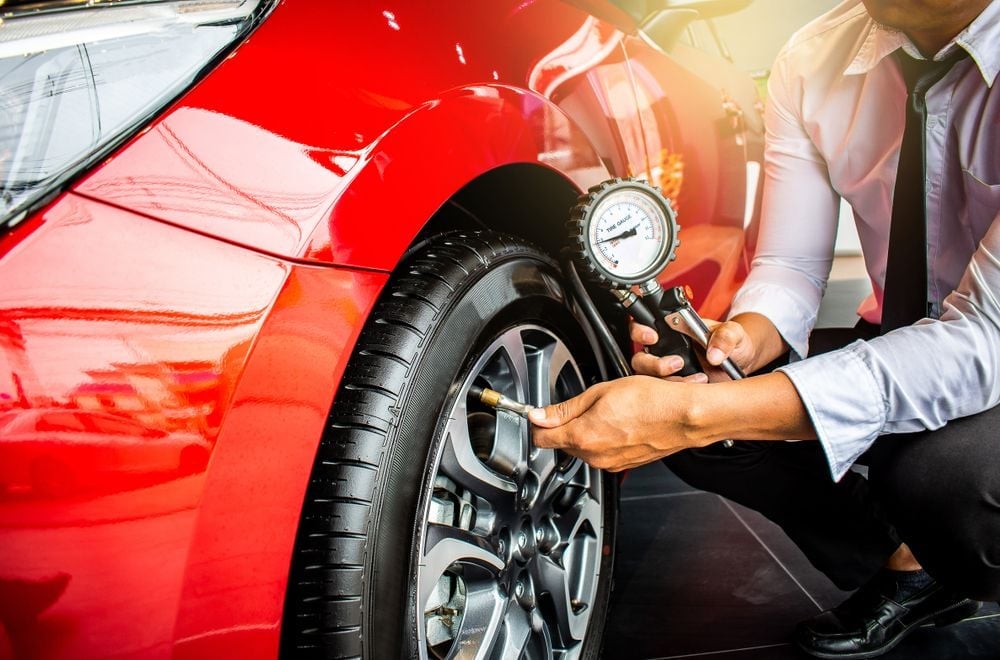
Have you ever seen your tire pressure monitoring systems light glow? This is because your tire pressure may be low.
Most tires have an optimal pounds per square inch (PSI) of 30 to 35, but anything lower than 20 PSI is considered too low.
While driving on an under-inflated tire during emergencies is fine, it isn't good practice as it can cause devastating blowouts and total loss of control.
Below, we'll discuss the distance you can travel with low pressure, how to use a pressure gauge and more.
 Filling a tire up to it's proper tire pressure.
Filling a tire up to it's proper tire pressure.
What Number Is Too Low for Tire Pressure?
Standard vehicles should have a tire pressure between 30 and 35 PSI, but always check your tire pressure against the manufacturer's recommended levels for optimal performance.
Anything below 30 PSI is considered low and should be avoided.
But too low is generally 20 PSI or below.
To accurately check your tire pressure, use a tire gauge like this:
- Remove the cap from the tire's valve.
- Press the gauge against the open valve for a couple of seconds (hissing sounds are normal).
- Read the gauge. On manual gauges, a dial or bar indicates the PSI. On digital ones, the reading shows on the screen.
- Compare the number with the recommended pressure.
- Replace the caps and repeat the process. Don't forget to check the spare tire.
How Far Can You Drive with Low Tire Pressure?
Driving with low tire pressure is incredibly dangerous.
Over 11,000 tire-related crashes occur in the United States of America every single year — not a statistic you should want to be involved with.
The lowest tire pressure you can drive on is 20 PSI.
While we don't recommend driving with such low tire pressure, it should be safe, and you shouldn't deal with any drastic tire wear unless the pressure continues dropping.
The distance you can travel with low tire pressure (i.e., under 20 pounds per square inch) shouldn't be very far; however, it depends on various driving conditions.
While you should only drive if necessary once the low tire pressure warning light shines, the following are acceptable distances:
- Paved roads — On paved roads and ideal conditions, you should never drive more than 50 miles or longer than an hour with under-inflated tires.
- Offroad — Never drive offroad with low tire pressure. If there's no other way around it, don't travel for longer than 10 minutes or 10 miles.
- Snow or wintery conditions — Properly inflated tires struggle with snow as it is; they find it difficult to gain traction and press forward. So, when a tire's air pressure is too low, it worsens. Ideally, don't drive more than 30 minutes or more than 40 miles here.
- Summer conditions — While there's no snow, there are higher temperatures. Go slowly and don't drive for longer than 30 minutes with low tire pressure. Otherwise, you risk a flat tire.
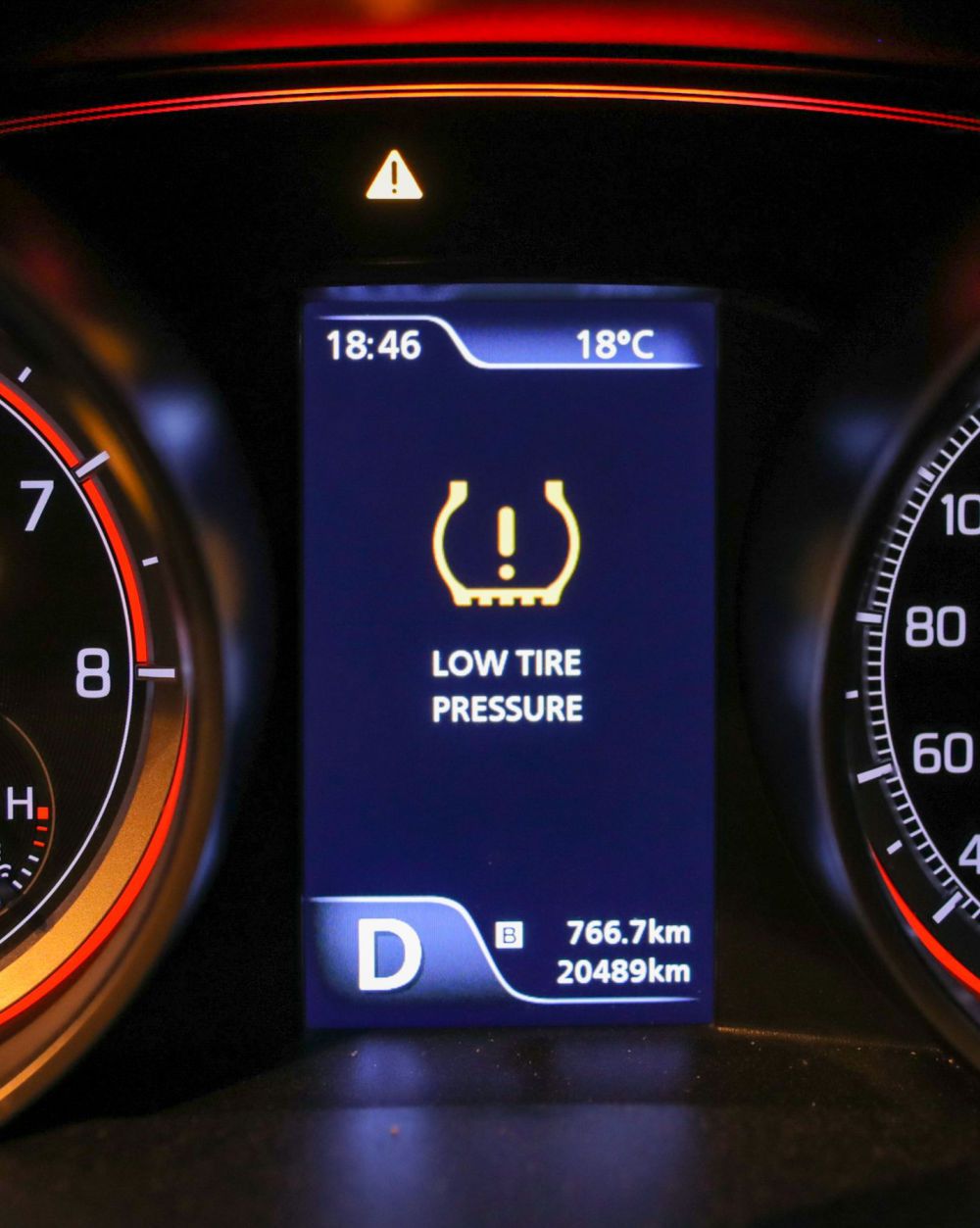 A low tire pressure warning light on the instrument cluster of a car.
A low tire pressure warning light on the instrument cluster of a car.
Low Tire Pressure Symptoms
The most obvious way to know whether your tire pressure is too low is by looking at the warning light on your dashboard.
Every car made in 2008 and beyond must have an onboard tire pressure monitoring system, so your vehicle is bound to have one.
That said, not every pre-2008 vehicle boasts this apparatus.
Therefore, many cars are still on the road without a TPMS light.
Whether you see the check tire pressure light or not and you're worried about the state of your tires, look at the owner's manual to discover the recommended pressure before assessing your current tire pressure.
Normally, your vehicle's performance is affected by inadequate tire pressure.
So, you'll likely notice the following:
#1 Fuel Economy
When appropriately inflated, tires combine grip and surface area to ensure a lower gas mileage.
Just like kicking deflated soccer balls, low tire pressures bog your vehicle down, meaning the engine has to work harder to roll it forward.
Low pressure isn't always noticeable while driving at normal speeds.
However, it can make a huge difference when traveling at high speeds.
In fact, you could lose up to three miles per gallon due to the under-inflation of tires.
Usually, low gas mileage occurs when multiple tires have low air pressure.
#2 Stopping Distance
When your tire pressure is below the ideal pounds per square inch, your stopping distance may be longer than normal.
Only astute drivers will notice this since it isn't generally the most obvious symptom of low tire pressure.
That said, studies show that stopping distance can often be severely impacted by one or more tires having less-than-ideal air pressure.
You'll notice the problem worsening during snowy and rainy weather.
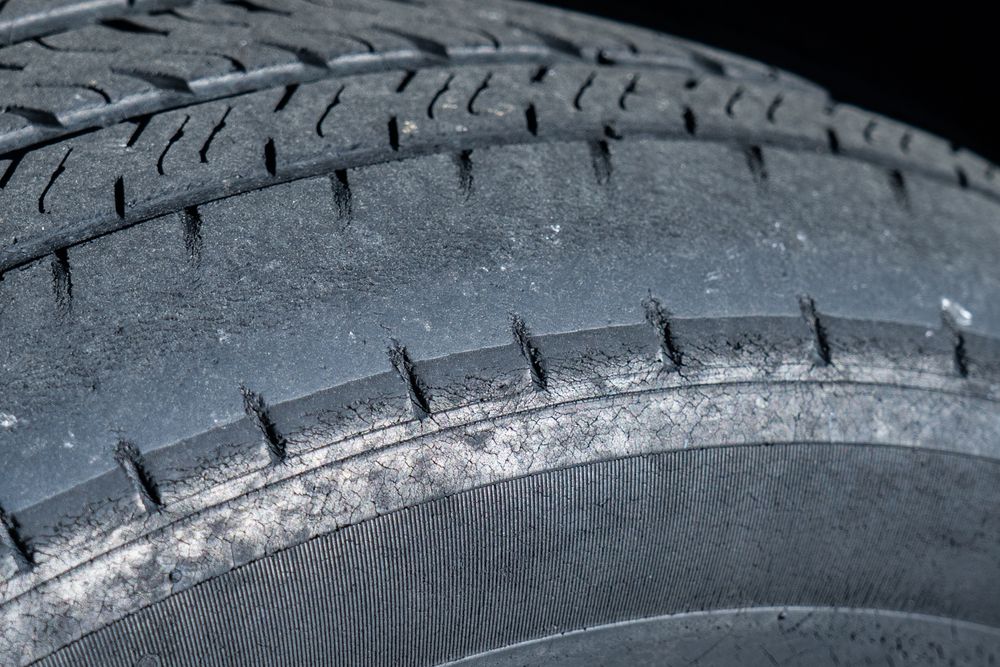 A tire showing an uneven wear pattern.
A tire showing an uneven wear pattern.
#3 Tire Wear
When underinflated, standard passenger tires don't wear uniformly.
Instead, they depreciate on one side quicker than the other, causing the tread to remain thicker nearer the middle of the tire.
The opposite happens with an over-inflated car tire — the middle shows premature balding.
Unfortunately, this isn't necessarily a great sign of incorrect tire pressure.
Why?
Because it can take over 12 months for the wear to appear.
#4 Driving Feel
Under-inflated tires are known to affect handling negatively.
If you've driven your vehicle for a while, you'll know exactly when something feels "off," making it a great indicator of not-so-good tire pressure.
Most vehicles were made to handle certain things under perfect conditions, and low tire pressure isn't any part of the equation.
Whether your tire pressure monitoring system warns you or not, the following can indicate inadequate tire pressure:
- Sloppy handling
- Difficulty driving in a straight line
- Imprecise steering
- Generally unsettling ride
Naturally, all the above worsens in adverse conditions.
If the worst comes to the worst, your car could experience less traction, losing control entirely.
Speaking of, not having enough air in your tires for a while without rectification can lead to two terrible consequences.
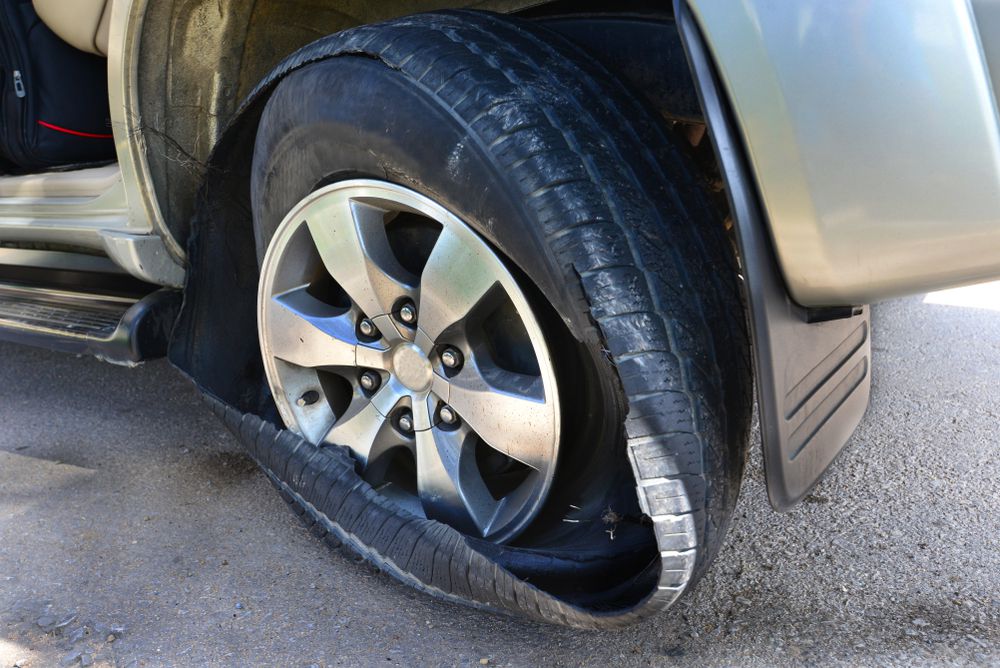 A tire blowout as a result of low tire pressure.
A tire blowout as a result of low tire pressure.
Tire Blowouts
Tire blowouts are the most dangerous.
They're caused by weakened structures or lots of wear.
The vehicle's weight and insufficient tire pressure can cause a sudden drop in air, leading to instant failure.
Often, a potentially devastating blowout comes out of nowhere.
However, it's important to stay calm.
You may hear a loud bang, followed by a jerk to one side.
Avoid an accident by:
- Tightly grabbing the steering wheel.
- Briefly press the accelerator to realign the car.
- Gradually allow it to slow down on its own as you pull over.
- When the vehicle reaches 20 to 30 mph, slowly push the brake to stop the car.
Sudden Loss of Control
With inadequate tire pressure, sudden control loss can occur at any moment.
If you're traveling at higher speeds, any loss of traction can cause crashes, even if you haven't suffered irregular handling beforehand.
Low Tire Pressure: What to Do
Knowing what to do when you don't have enough tire pressure is vital to your safety to avoid a potentially catastrophic blowout or total loss of control.
The crux of the matter is — you need to add air.
Luckily, most gas stations have air pumps that you can use to top up to your tire pressure recommendations.
Nowadays, most machines take credit card payments, usually costing between one and two dollars.
After payment, you get enough time to fill your car tires to the desired air pressure.
Here's how to fix your tire pressure:
- Ensure you park near the air pump. The hose should reach all four tires easily.
- Look at your owner's manual to determine the recommended air pressure. Most manufacturers print it on the inside of the driver's-side door jamb too.
- Remove valve stem covers.
- Check tire pressure.
- Push the end of the air pump hose into the valve stem.
- Depress the lever if there is one. Some let you set the pounds per square inch you want beforehand. If you can't put the PSI on the machine, check tire pressure throughout to ensure you don't inflate your tires past the recommended level.
- Press the center prong inside the valve stem if you need to release excess air.
- Refit the valve stem caps.
Driving with Low Tire Pressure
As mentioned, driving with low tire pressure isn't ideal.
But sometimes, you don't have a choice.
There's more to it than the distance — you need to understand the speed you should go with under-inflated tires and other tips and tricks to make the ordeal as safe as possible.
When driving on low tire pressure, you risk a flat tire, which could result in a terrible accident.
So, the fastest you should drive without tires properly inflated is 50 miles per hour.
Any faster, and you're putting yourself at risk.
Please bear in mind that this is the maximum limit!
We always recommend driving as slowly as possible with low air pressure in your car's tires.
If you're stranded with an underinflated tire, keep the following tips in mind if you must drive:
- Remove weight — Make sure your vehicle is as light as possible. Luggage and other items should be removed when driving with low tire pressure.
- Stay slow — Always drive below 50 miles per hour, preferably much slower.
- Stay close — Don't drive over 50 miles or the recommended range according to weather conditions and terrain.
- Only drive in the right lane — Stay in the right-hand lane so you can pull over instantly if the worst happens.
- Turn your hazards on — Warn other drivers of your tire pressure situation, so they stay away for everybody's safety.
Remember that it's illegal to drive with a flat tire.
To adhere to federal law, you must inflate your air pressure to adequate levels.
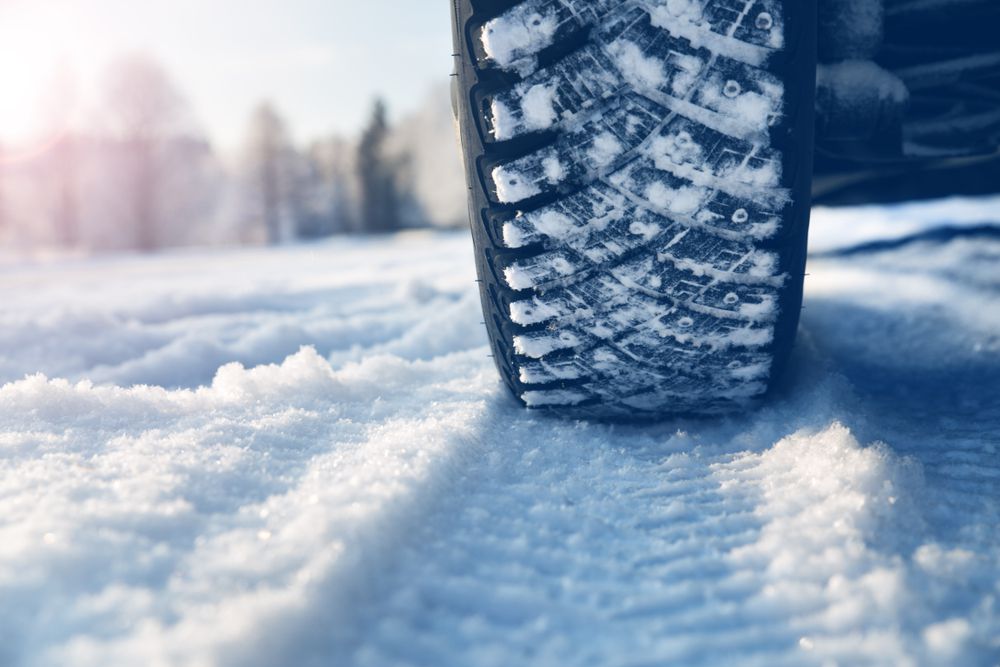 A tire on a winter road.
A tire on a winter road.
What Tire Pressure is Too Low in Winter?
When the temperature drops considerably, your tire pressure follows.
The air molecules slow down and become stuck, causing decreased tire pressure.
Some tire manufacturers state that for every 10 degrees the temperature drops, your tires lose one PSI.
Tire pressure monitoring systems trigger when at least a 25% reduction in air pressure occurs, making it a useful gauge.
Despite the common belief that lower pressures are good for wintery conditions, you should stick to your car's manufacturer's recommendations of between 30 to 35 pounds per square inch.
What Tire Pressure is Too Low for a Truck?
Truck tire pressure depends on the load.
Therefore, checking the load/inflation tables published by your tire manufacturer is key to determining proper tire pressure.
Generally speaking, truck tires should be around 100 PSI, but this is heavily dependent on the weight of the load.
In colder temperatures, maintaining correct PSI is tricky — every 10 degrees drop equals a loss of two pounds per square inch.
However, you should never attempt to add air to a cold tire, as the pressure may return to normal on the tire gauge when the outside air has warmed.
Conclusion
Pressure below 20 PSI is considered too low.
Driving with inadequate pressure is only excusable in emergencies.
Otherwise, you should avoid driving and rectify the problem for proper fuel economy, performance, and safety.